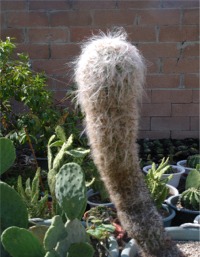SIZE AND GROWTH:
PROPAGATION:
Cephalocereus senilis (
also called
Old Man cactus) is a species of cactus native to Guanajuato and Hidalgo in
eastern Mexico. It is threatened in the wild, but widespread propagation and
popularity in cultivation have reduced the demand on wild populations.
It is a tall, columnar species with clusters of stems that may grow to 5–15 m
tall; the individual stems are usually unbranched, being unable to withstand
the weight of side branches adequately. The most striking feature is the
shaggy coat of long, white hairs suggestive of unkempt hair on an old man. The
coat is a particularly striking silvery white on the young cactus; as the
plant ages the stem begins to lose its covering. The flowers are red, yellow,
or white, though the plant may not flower until 10–20 years old. The
hairs are modified spines and they make many a plant appear almost snow-white;
they serve to protect the plant from frost and sun. However, the hairs are
only the radial
spines of the cactus; they conceal formidable sharp yellow central spines
that belie the inoffensive appearance of the hairy covering.
Growth Habits: Cephalocereous senilis grow
quite straight but will sometimes branch from the base to form a group of
parallel stems. It will flower after many years of establishment with
yellowy white trumpet shaped blooms - but they only come out at night. Large, cylindrical cactus growing to over
15ft
high and 2ft diameter; Growth rate: Slow.
Cephalocereus senilis is a tall,
columnar species with clusters of stems that may grow to 15-40ft tall; the
individual stems are usually un-branched. The most striking feature is the
shaggy coat of long, white hairs suggestive of unkempt hair on an old man.
The coat is a particularly striking silvery white on the young cactus; as
the plant ages the stem begins to lose its covering. The flowers are red,
yellow, or white, though the plant may not flower until 10–20 years old.
Recommended Temperature Zone: USDA: 9, 10, 11
, 12
; Frost Tolerance: Hardy, to 10° F at least;
Minimum
Avg. Temp: 50° F (10°C)
; Sun Exposure: Sun;
Watering
Needs: Moderate
in summer
, drier in winter;
Blooming
Habits: Flowers are red, yellow white;
Speed of Growth: Slow;
Mature Height: 15ft
; Mature Width: 2ft
; Fruiting Habits: N/A;
Maintenance: None
:
Container, Drought Tolerant, Houseplant, Rock Garden, Xeriscape
Seeds; unimproved desert soils. It is threatened in the wild, but
widespread propagation and popularity in cultivation have reduced the
demand on wild populations. These plants are becoming very uncommon
due to the fact that all available seed has been shut off by the Mexican
government. .

ABOUT
cephalocereous senilis:
LANDSCAPING USES
CULTIVATION:

